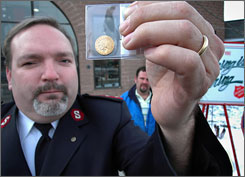By Oren Dorell, USA TODAY
Anonymous Santas have been dropping gold in Salvation Army kettles across the country, delighting the bell ringers who come out every Christmastime to take in spare change for the poor.
"Whoever does this is very clever about putting the money in the kettle because we never know what he's doing," says Sue Hennings, spokeswoman for the Waterloo, Iowa, chapter of the Salvation Army. "It truly makes it Christmas." A 1978 South African Krugerrand was found in a kettle in Iowa on Saturday, and two gold American Eagles were discovered in Vermont and Florida last week. The Waterloo chapter of the American Red Cross has received a gold coin every year for seven years, Hennings says. "It's the prettiest little thing I ever did see," Hennings says of the Krugerrand, which has an antelope on its back and is worth $670. People have been dropping valuables in the red kettle for years: • In Fort Lauderdale two years ago someone dropped in a ⅓-carat diamond engagement ring. It was discovered after it got stuck in a coin counter. •In Minneapolis a man who requested anonymity slipped a check for $14,845 into a kettle outside a book store. The tradition appears to have started in the Midwest. The first gold coin was donated in Crystal Lake, Ill., a Chicago suburb in 1982, says Melissa Temme, spokeswoman for the Salvation Army. Since then more than 300 gold coins have been donated. "It was the actual thud that caught my attention," says Capt. David Worthy, who heads the Salvation Army in Panama City, Fla. "As soon as I picked it up I knew what it was." The coin was a 1993 American Eagle with an estimated value of $600 to $900, he says. "We couldn't believe it, just because our community is so small," Worthy said. An American Quarter Eagle worth as much as $14,000 landed in a Salvation Army's kettle in Berlin, Vt., last week. "Our volunteers are beaming with excitement now," Capt. Louis Patrick says. "It's really boosted our spirits — our Christmas spirits." In Denver the Salvation Army was visited by the Grinch, however. Someone dropped an 1804 silver dollar into the kettle, or so it was thought, according to Rod Gillis, a numismatic educator at the American Numismatist Association. Gillis had to explain to the excited Salvation Army worker who called him "that there is a very, very slim chance that that was real." He said all 15 1804 silver dollars minted are accounted for. Had it been real, it would've been worth up to $4 million. But millions of real dollars worth of coins go clanking into the kettles every year. The Salvation Army says about $100 million is donated in the few weeks leading to Christmas. For many chapters, the kettle drive is its main source of money for its work. Hennings says its five-week red kettle fundraiser will pay for Christmas gifts, dinners for more than 900 Waterloo families and meals for the needy all year. "It's like a Christmas miracle," Temme says. "And who doesn't love a Christmas miracle, especially when it changes lives."
|
||||||||||||||||||
